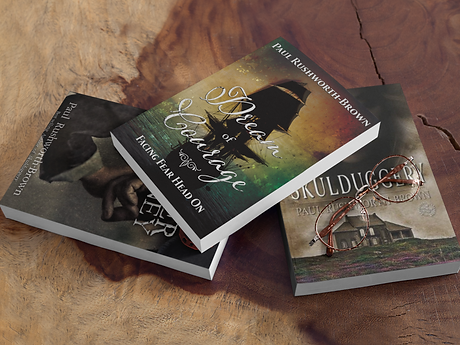
By Amanda Smith

Introduction
Literary Comparison: DK Marley and Paul Rushworth-Brown: DK Marley and Paul Rushworth-Brown are two contemporary authors whose works have captivated readers with their rich narratives and profound themes. Marley’s "Blood and Ink" and Rushworth-Brown’s "Dream of Courage: Facing Fear Head On" offer a fascinating study of contrasts and similarities, particularly in their handling of historical settings, character development, and thematic explorations.

Historical Settings
DK Marley: In "Blood and Ink," DK Marley delves into the tumultuous period of Elizabethan England. Marley's meticulous attention to historical detail creates a vivid backdrop, transporting readers to a time of political intrigue and artistic flourishing. Her portrayal of the era is both immersive and educational, weaving accurate historical figures and events seamlessly into the fabric of her narrative.

Paul Rushworth-Brown: Paul Rushworth-Brown, on the other hand, sets "Dream of Courage: Facing Fear Head On" in the rural Yorkshire of the 17th century. His depiction of the period is grounded in common folk's daily lives and struggles, providing a raw and unfiltered glimpse into the past. Rushworth-Brown’s ability to evoke the atmosphere of the time through dialect and descriptive prose brings authenticity to his work.
Character Development
DK Marley: Marley excels in creating complex, multi-dimensional characters. In "Blood and Ink," her characters are often caught in the web of historical events, their journeys intertwined with the larger socio-political landscape. Marley’s protagonists are typically driven by a quest for identity and purpose, making their internal struggles as compelling as their external conflicts.
Paul Rushworth-Brown: Rushworth-Brown’s characters in "Dream of Courage: Facing Fear Head On" are deeply rooted in their environment and community. He focuses on the resilience and courage of ordinary people confronting extraordinary challenges. Rushworth-Brown’s characters are portrayed with a gritty realism, their development reflecting the harsh realities of their time and place.
Thematic Explorations
DK Marley: Themes of art, identity, and power permeate Marley's "Blood and Ink." She explores the transformative power of creativity and how it intersects with politics and personal ambition. Marley’s narrative often delves into the moral ambiguities of her characters' choices, reflecting the complex interplay of personal and historical forces.
Paul Rushworth-Brown: In "Dream of Courage: Facing Fear Head On," Rushworth-Brown tackles themes of fear, courage, and survival. His work is a testament to the human spirit’s capacity to endure and overcome. Rushworth-Brown’s exploration of fear is personal and universal, examining how it shapes individuals and communities. His theme focuses on the inner strength and solidarity needed to face adversity.
Writing Style
DK Marley: Marley's writing style is characterised by its lyrical quality and rich, descriptive language. Her prose is both elegant and evocative, capturing the reader's imagination with its vivid imagery. Marley’s narrative pacing is deliberate, allowing for deep exploration of characters and settings.
Paul Rushworth-Brown: Rushworth-Brown’s style is more direct and unadorned, reflecting the straightforwardness of his characters and their lives. His use of regional dialect and colloquialisms adds authenticity to his dialogue and narrative voice. Rushworth-Brown’s pacing is brisk, driving the story forward with urgency and immediacy.
Conclusion
While DK Marley and Paul Rushworth-Brown both excel in bringing historical periods to life, their approaches to storytelling are distinct. Marley’s "Blood and Ink" is a tapestry of intricate plots and richly drawn characters set against the grand stage of Elizabethan England, whereas Rushworth-Brown’s "Dream of Courage: Facing Fear Head On" offers a gritty, realistic portrayal of 17th-century Yorkshire, focusing on the resilience of ordinary people. Together, their works provide a diverse and enriching reading experience, each illuminating different facets of the human condition through the lens of history.
"History shows Kit Marlowe died in a tavern brawl in Deptford in 1593, but did he? Amidst England's religious turmoil and espionage, young Christopher Marlowe is drawn into a world of secret spy rings, murder, and betrayal. His ambition to become England's favorite playwright fades as he becomes entangled in darkness. A fateful meeting with William Shakespeare leads to Marlowe's forced exile and the revelation that his true enemy is someone he never suspected.
Set in the heart of 18th-century England, "Dream of Courage" follows John and Robert Rushworth as they leave the desolate moors for the gritty alleys of Leeds, aiming to escape poverty and achieve greatness. Their journey is fraught with danger and uncertainty, navigating a world of beggars, thieves, and outlaws.
The enigmatic tavern keeper Smythe, a pirate captain named Girlington with hidden secrets, and the relentless Jacob Wilding, who seeks to capture Robert for a perilous reward, all play crucial roles in their story.





.png)

.png)

.png)
.png)



.png)






Comments